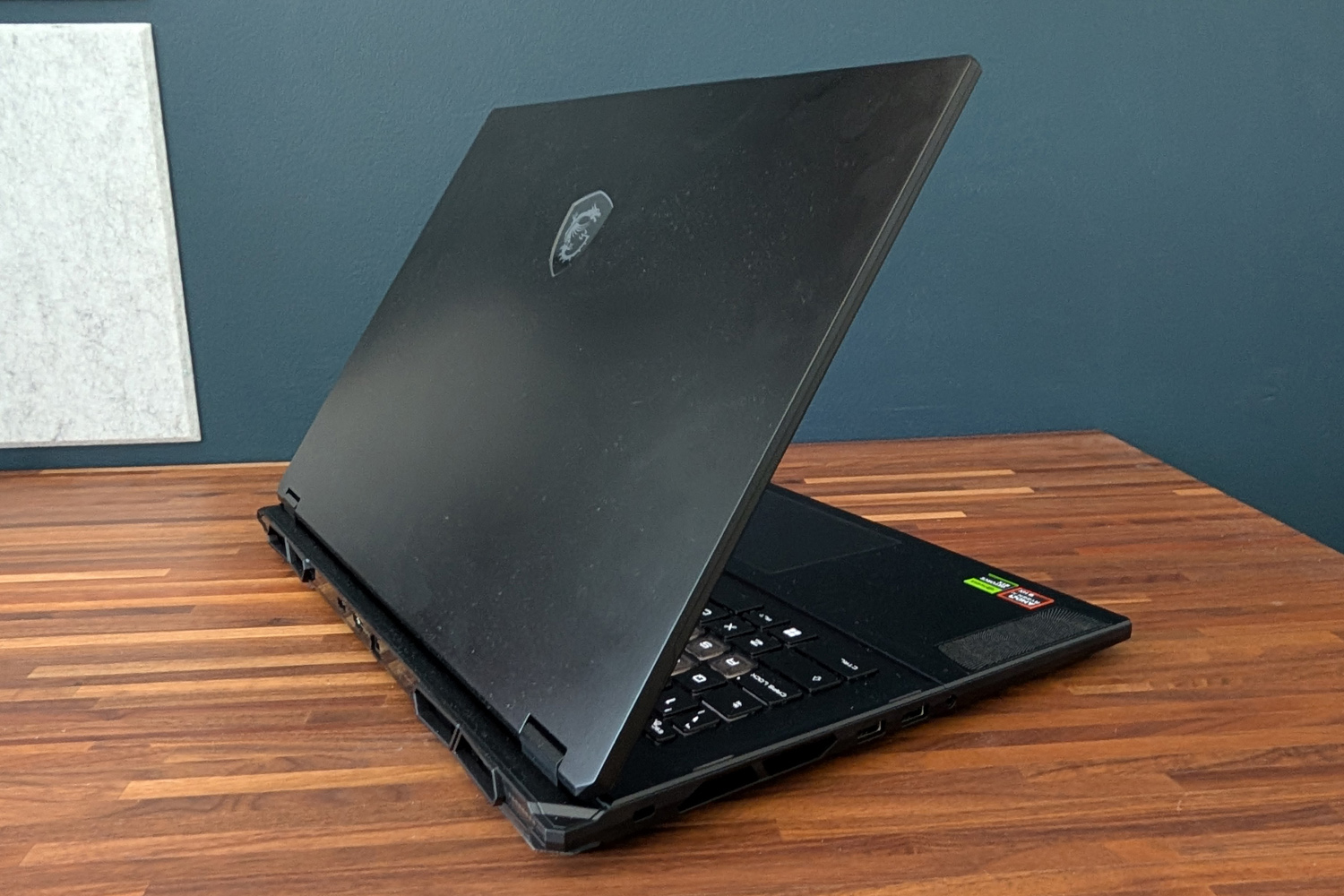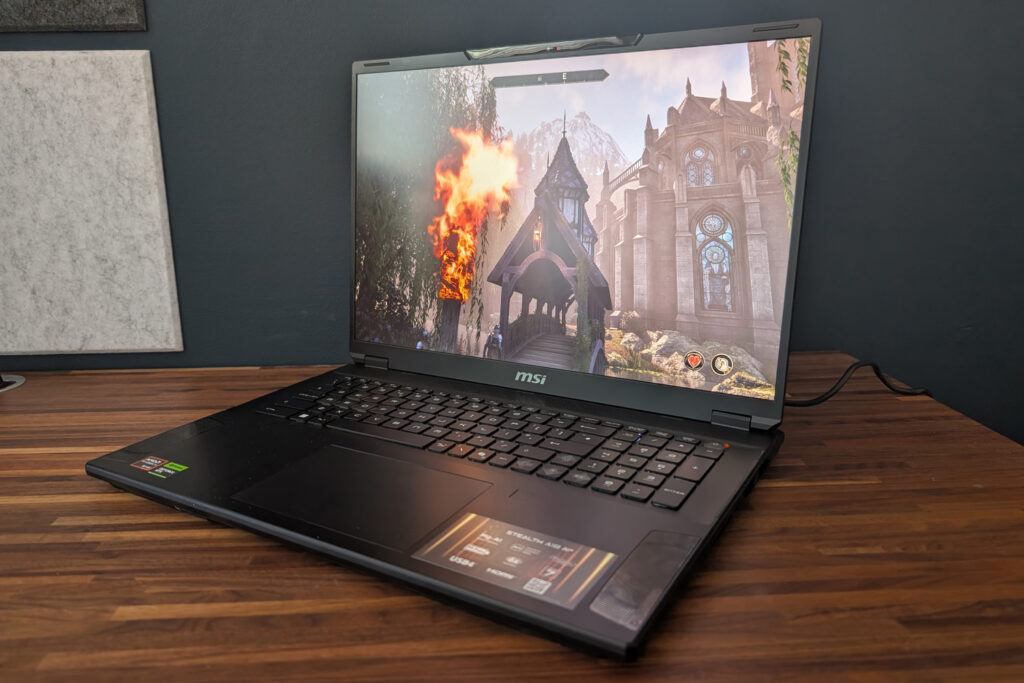Introduction
Legions of gamers might’ve salivated over Nvidia’s top-tier RTX 5000 series graphics cards when they launched at the start of 2025, but considerably fewer were willing to sell a kidney in order to afford one. Happily gaming laptops with more mainstream GPUs are finally starting to arrive, at prices that aren’t quite so wince-inducing. The MSI Stealth A18 AI+ is the first I’ve tried with a n RTX 5070 Ti, which might offer the best bang per buck of the entire line-up.
Sitting beneath MSI’s Raider and flagship Titan models, the Stealth offers a choice of Intel and AMD chipsets and promises subtler styling than some of the firm’s more out-there options. It’s primarily a desktop replacement, but the Ryzen AI 9 CPU inside my review unit means it can also survive away from a plug socket for longer than you expect.
At £2899 as tested (or $3300 in the US for the closest HX equivalent, which has an Intel Ultra 9 CPU instead) it’s by no means cheap – but undercuts big-screen behemoths from the likes of Asus, Razer and Lenovo by some margin. Can it hit the price-to-performance sweet spot?
Design & build: hidden in plain sight

As the name suggests, the Stealth is nowhere near as in-yer-face as the average gaming laptop. The magnesium-aluminium alloy chassis is relatively slender and isn’t festooned in RGB illumination or giant air vents. The screen hinge also goes right up to the rear edge, instead of part-way to accommodate the chunky thermal shelf seen on higher-end rivals.
Admittedly it’s not as minimal as a Razer Blade 18, with a few more sharp angles and a pair of distinctive speaker grilles either side of the touchpad, but the all-black finish means it won’t stand out too much if you whip it out in public. At 2.89kg (not counting the considerable power brick) you’re not going to want to lug this around with you everywhere, though.
The alloy build doesn’t feel as cool to the touch as a full aluminium one, and it’s a little less rigid too; there’s a fair bit of flex around the keyboard tray. My review unit was otherwise free from creaks and groans. The screen hinge is light enough to open with one hand, but stays firmly in place no matter which angle you open it to.
I appreciate having both facial recognition and fingerprint security, even if the latter’s sensor being off to the side of the touchpad instead of built into the power button makes it feel a little like an afterthought. Having both set up makes skipping the Windows lock screen that bit easier if your room’s lighting conditions make the webcam struggle to see you clearly. The sliding shutter is nice for privacy, too.
Connectivity is pretty decent, with the HDMI 2.1 and Ethernet ports sensibly located at the rear next to the bespoke power connector. It makes taming cables that much easier, which is a big deal for a desktop replacement laptop. The twin USB4 type-C ports on the right aren’t quite so convenient if you have limited room left over for your gaming mouse. Creative types will find the full-size SD card reader useful, though. Two USB 3.2 Gen 2 type-A ports and a 3.5mm combo audio port on the left side complete the set.
Keyboard & touchpad: a splash of colour
A set of full-size numerical keys aren’t always a given on 18in laptops, so MSI gets a thumbs up for finding room for them on the Stealth A18 AI+. The QWERTY keys are pretty much all full-size too, with just the function row using half-height ones. Translucent key caps help the WASD and arrow keys stand out, and really highlights the per-key RGB backlighting. MSI’s partnership with Steelseries continues into 2025, so all the effects are controlled through the peripheral specialist’s software.
You won’t find mechanical key switches here – those are reserved for MSI’s flagship models – but the typing experience is otherwise pretty good. There’s a good amount of travel in each key, they bottom out firmly, and don’t rattle as your fingers roam across the board. I had no trouble typing on it once I’d gotten used to the offset layout, which means your wrists are resting over the touchpad. Palm rejection could be a little funky at times. Of course you can always disable the touchpad if you’ll be gaming at a desk with a mouse handy.
The touchpad itself isn’t the biggest I’ve seen on an 18in laptop, and it’s a physical click rather than a haptic one. I imagine that helps keep costs in check. It’s sensitive enough to cover the entire screen in a single swipe, but that swipe isn’t as satisfying as it would be if the pad was made from glass instead of plastic. Then again, how much will that bother you if you’ll mainly be using a mouse?
Screen & sound: a good match for the GPU
Some versions of the Stealth A18 get a 4K resolution mini-LED screen, but the entry-grade model I tested sticks with an IPS panel. You do get double the refresh rate here, though – 240Hz to the pricier model’s 120Hz – and the QHD+ resolution is arguably a better fit for the RTX 5070 Ti GPU, without being so low you can spot the pixel structure from across the room.
While it can’t hope to match pricier screens for contrast or black levels, it does gets decently bright enough for daylight use and colours look fairly punchy. Accurate, too, once you swap out of the entertainment-biased picture modes in MSI’s True Color app (which also supports most big-name colorimeters if you need to calibrate it for creative tasks).
The matte finish helps keep light reflections at bay, and there’s no shortage of tilt angle, although viewing angles are really only average. There’s no HDR support, either, which is a bummer given what a difference it can make in compatible games. If you’ve got an HDR-ready external monitor, you’re going to want to game on that instead. If you don’t, I’d probably spend the extra on a version with the mini-LED screen.
I was impressed with the accompanying six-speaker array, which combines two up-firing tweeters with four down-firing woofer drivers all tuned by Dynadio. There’s plenty of volume here, enough that I didn’t need headphones or external speakers to soundtrack my workday. It was never going to deliver furniture-shaking bass, though, so a headset was still my first choice for gaming.
Performance: upscaling is here to stay
Exact specs will vary depending where in the world you live, but basically the 18in Stealth can be had in Intel (known as the Stealth 18 HX AI) and AMD (Stealth A18 AI+) varieties. I was sent the latter, with power coming from a Ryzen AI 9 HX 370 processor. This twelve core, 24-thread chip is based on AMD’s Zen 5 architecture and sits in the middle of the firm’s laptop line-up. Here it’s paired with 32GB of RAM and a 2TB NVMe SSD, plus that all-important RTX 5070 Ti GPU – which as 12GB of dedciated video memory.
It’s a great desktop performer, if not a total powerhouse – but that’s not a shocker given the price. AMD excels in multi-threaded tasks right now, with a score of 12969 in the Geekbench 6 multi-core test confirming it’s a great choice for video editing, rendering work and other creative tasks. Raw single-core performance isn’t quite as high, but it’s still able to compete with Intel’s latest-gen chips. The NPU part of the chip is also very capable when it comes to AI workloads.
AMD is doing great things on the efficiency front right now too, so the Stealth A18 AI+ can last longer than you’d expect away from the mains. It helps that MSI has also stuffed the biggest battery possible inside, meaning you get 99.9Whrs of juice. I went from fully charged to a flat battery in a smidge over three hours when playing a YouTube video at half brightness using the power efficiency preset. That’s upwards of an hour longer than I managed from an Intel gaming laptop recently.
Let’s be honest, though: you’re here for the gaming scores. The RTX 5070 Ti is permitted 150W of total thermal power, thanks to a dual-fan vapour chamber cooling system, and is a performance step up from the previous generation pretty much across the board.
In Shadow of the Tomb Raider, I saw 93fps at native resolution and maximum details; an RTX 4070 laptop managed 66fps on the same settings. The 5070 Ti’s extra video memory helped it deliver 77.6fps in Indiana Jones and the Great Circle, while the last-gen card struggled with the large texture pool and could only manage 45.9fps. Cyberpunk 2077 hit 75.6fps on the Ultra preset, versus 48fps on an RTX 4070 laptop. Most, if not all, modern titles will be playable at QHD resolution here unless ray tracing comes into play.
With RT enabled and Cyberpunk set to the Overdrive detail preset, native performance topped out at a stuttery 17.2fps. Nvidia’s DLSS makes all the difference, boosting frame rates dramatically to 181.8fps. Multi-frame generation is largely to thank, and despite coming from such a low base frame rate, felt fantastic in motion. Crucially the latest version of DLSS has cut out almost all of the shimmering and softness associated with the tech, so I was far more inclined to use it than I had on last-gen hardware.
Interestingly, though, the 5070 Ti doesn’t outperform the RTX 4080. Nvidia’s newer cards are usually as good as the next card up from the generation before it, but not here. Depending on the title some games perform as well, while others show a bigger gap. That could make a discounted 4000-series system a better buy, at least in the short term.
MSI Stealth A18 AI+ verdict
In isolation, the MSI Stealth A18 AI+ is a consistently decent gaming laptop with a sensible combination of screen resolution and GPU. Every title I tried was playable at well over 60fps with DLSS and frame generation, while native performance isn’t too shabby either. The AMD silicon is also more than able to pull its weight, and can survive for a few hours on battery power when it has to.
The screen is merely OK and the build can’t match pricier rivals, but those currently cost significantly more as they’re packing 5080 and 5090 graphics. That’ll change once the RTX 5070 Ti becomes more readily available, but as of right now this is a very capable current-gen desktop replacement at a far more palatable price. That said, if you spot an RTX 4090 laptop at a similar price there’s still plenty of life left in that GPU generation.
MSI Stealth A18 AI+ technical specifications
| Screen | 18in, 2560×1600 IPS LCD w/ 240Hz |
| Processor | AMD Ryzen AI 9 HX 370 (12-core, 24-thread) |
| Memory | 32GB |
| Graphics | Nvidia GeForce RTX 5070 Ti w/ 12GB VRAM |
| Storage | 2TB NVMe SSD |
| Operating system | Windows 11 |
| Connectivity | 2x USB-C, 2x USB-A, 3.5mm combo port, HDMI 2.1, Ethernet, SD card reader |
| Battery | 99.9Whr |
| Dimensions | 400x290x19.9-24mm, 2.89kg |
Read the full article here
